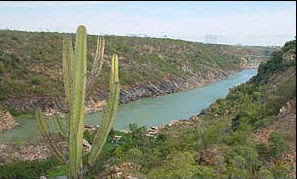Being located in thick jungles and off from main-road; the Mayan ruins of Coba is not as popular as those of Tulum or
How to get there
From Tulum at the traffic light in section of the
They also made sacbes
These are white limestone laid roads typical to the Mayan civilization. Sacbes in Mayan means white road. These sacbes are centered in Coba and from there they stretch to various monuments, and to the
Protected by forests
The site of Coba got the name from
The Coba site is at Quintana Roo in the Thick jungles. The path that leads to the Coba site is forested with abundance of wild life like spider-monkeys, vultures, squirrels, lizards, scarlet-macaw, toucans (toucans are tropical American birds with enormous beaks and bright plumage) and even jaguars.
Least explored
This site was opened to the public only in 1973; only few of the 6000 structures have been cleared so far. The remaining structures are still lying covered by the thick forests for the last several centuries. The whole Coba site spreads to about 60 sq km, only in 1920 exploration works started here because of the remoteness of the site.
The Castillo at Coba
The Castillo of Coba is at the center of the whole site of ruins which spread to an area of 1500 sq feet. It is a step pyramid looking like a steep cliff with a height of 78 feet built with nine terraces. This pyramid has been described as a light house and probable it would have served to carry lantern at that times.
This pyramid has vaulted rooms that are supported by feathered serpents which support its roof with their tails where as their heads are held low to the floor. Stairways are provided up to the seventh floor from there a wall stands that supports the base of a small temple that is built at the top of the pyramid. The temple has only a single door.
There is one temple north to the Castillo it is for worshipping the ‘God of the Winds’. It is said that this temple is so designed that it will blow warning whistle when hurricanes come (the last hurricane said to have made the temple blow whistle).
La Iglesia
It is the first object that appears before the visitor is the 65 feet tall structure that is too steep. In height it is the second tallest pyramid in the site. It is believed that this structure was used for community ceremonies.
Ball Courts
No Mayan Sites is complete without a Ball Court with iron hoops like that of basket ball court, these were said to be places of fun often spilled blood; the captain of the losing team (in some instances the entire team that lost the game!) would be hanged on the hoop.
Nohoch Mul
The Nohoch Mul is another pyramid at about 1 km northeast to it by name the Castillo; it is 78 feet high and stands between 180 sq feet of ruins. It is a classic case of Mayan architecture and resembles that of
Climbing is possible through the loose stone blocks stacked one over the other as there are no stable hand rails (only a rope is placed vertical descent can be done by catching the rope! Descend is risky and tiresome. One wrong step may speed up your descend to the bottom.
Lakes Macanxoc and Coba
The Mayan Ruins at Coba lies between two
History
The most ancient culture (2300 BC) of this region is that of Olmec which was the source of the cultures (including the Mayan) those emerged later. The Olmecs were experts in rock carving; large human heads (known as Tolmec Heads) they carved on sandstones lie still intact in these sites.
The
A D
13th century AD belonged to the Aztecs who were battle hardened vagabonds of the deserts who came to power and established an empire in the speed of a lightening.
The Mayan culture is very much influenced by all these empires and cultures stated above. They had only hieroglyph and inscriptions on rocks and Stele (Upright stone or slabs with inscriptions or relief design). It is from these vague signs archaeologists work their way to trace events that has occurred 15 centuries back.
In the first century Coba was a city with a population of 50,000 people. Most of construction is believed to have happened between 500 to 1000 A D. The main occupation remained agriculture but maritime and land routes converged there made it a trade point.
Maya cities acted like independent states in all aspects, they made mutual alliances, fought each other, traded goods across boundaries, their sacbes crossed the forests here and there. Markets were filled with maize, beans avocados (a pear-shaped fruit with smooth flesh) etc.
Their life-style
Archaeologists have done further researches to study the style of life those people led and about their level of literacy etc. As per evidences it has been established that the noble men, priests and people with influence of Mayan society lived in high walled ramparts lived in comfort or were engaged in doing researches in mathematics, astronomy and theological wisdom. Kuhul ajaw (holy lords) mediated people with gods, they directly drew power from the gods, conducted elaborate rituals to please gods.
Fire is Born
Of all the kings who ruled the Mayans ‘Fire is Born’ remains as a superstar. He came from the
The end
Migrants from
Ghost Stories!
First they lost their land; then their pride; their loss was complete with conversions, what remained with them as their soul also parted ways. These unfortunate tribals; the Mayans became mere ghosts and what all these ruins have to tell are all mere ghost stories!



















